Blog by Pierre Bieber – Responsible Risk- Identification, Modelling and Evaluation at ONERA, the French Aerospace Lab.
When a new technology is being introduced, such as Artificial Intelligence in Condition Based Maintenance, you start by identifying the effects of this technology on the safety of people, goods and environment. This so called ‘hazard identification’ has been done and made publicly available for the first time on CBM in aviation as part of the ReMAP project (Deliverable 7.1).
Would the mentioned hazards be applicable to you?
Perhaps you are not fully aware of the potential problems that arise with the CBM technologies you use or produce. Hazards described in this ReMAP-document were identified by collecting the expertise of KLM aircraft maintenance specialists and by reviewing the associated literature including investigation reports and health-monitoring normative documents (ao EASA, FAA, AAIB and AIBN). This ReMAP-document is of importance for users and technology providers of CBM-products, and could be seen as a first guide in the CBM-implementation in your aircraft:
- Learn from the KLM Aircraft Maintenance Specialists
As a provider of new CBM technology you might not be fully aware of their usage in practice. This guide should be mandatory literature for you, because the results of two brainstorming sessions with KLM experts are processed in it. You can learn from the operational hazards as distinguished by the safety managers, maintenance planners and engineers which could be applicable to your technology. - Unveil the CBM-Black Box for the User
As a user you are generally very good at identifying the operation problems you encounter when you use well-established technologies in practice. But AI and other data intensive technologies can be experienced as a black box and it is not easy to imagine what new problems could be caused by them. We have analysed challenges related with these technologies that are mentioned in the ‘EASA AI/ML Roadmap’ (published 7th Feb 2020). It would be of interest for you to look at what you should be aware about and learn from it to use CBM correctly. Apart from your real life experience there may be other hazards that you did not think of.
‘ReMAP Framework’ seen in the context of the regulatory framework
This ReMAP Document is a first step in the safety assessment of CBM technologies in aviation. According to the regulatory framework defined by EASA and FAA, once you are aware of potential hazards, the next step consists in finding solutions to deal with these hazards and assessing the efficiency of the proposed solutions. I refer to the fine work of PhD Juseong Lee, his supervisor Mihaela Mitici (TU Delft) and Floris Freeman (KLM) who translate all these hazards into models for aircraft maintenance, with and without CBM incorporated. That is an incredible and unique achievement from which you can assess the impact on the aircraft safety when CBM is incorporated. Since new CBM technologies emerge faster than the evolution of regulations we might also have to propose adaptations of regulations when they are not applicable. We have fruitful interactions with EASA and with other aviation maintenance stakeholders in order to facilitate the future use of CBM technology and to avoid any kind of regulatory obstacles.
The next step: showcases with Embraer and KLM
The proof of the pudding is in the eating, so we will implement this framework into practice with showcases provided to us by the ReMAP-partners Embraer and KLM. Of course we will share the results amongst the community. So stay tuned and let’s learn from each other in this interesting journey.






